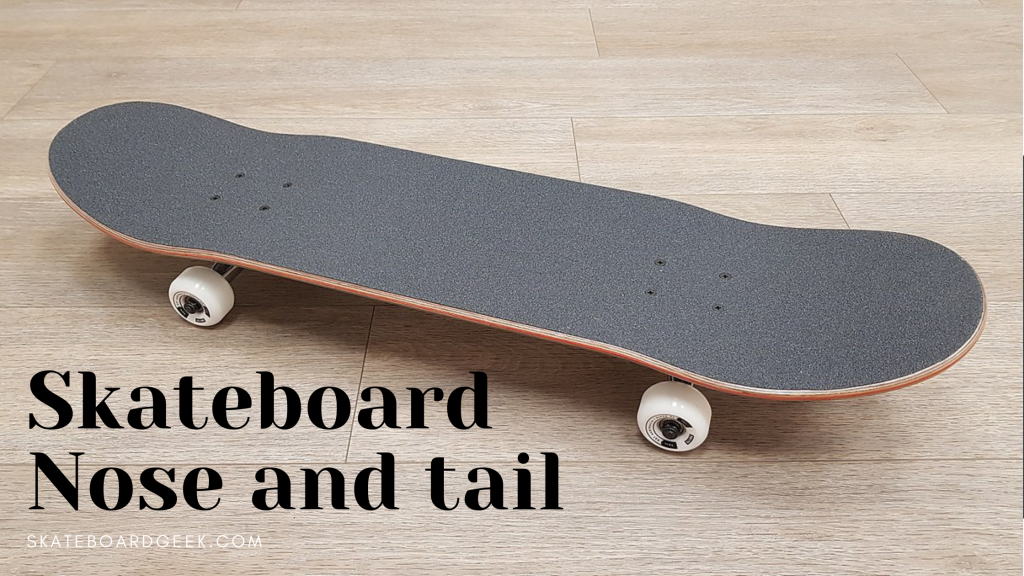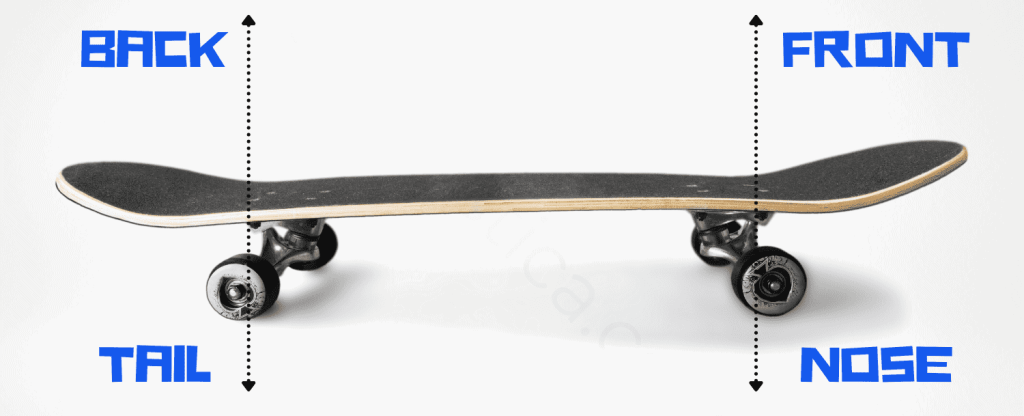Beginner skateboarders mostly find it hard to distinguish between the skateboard nose and tail. Both are the most essential components of a skateboard, and they play a crucial role in helping you execute tricks and maneuver. Moreover, they can also affect the overall feel and performance of your ride.
The nose and tail are the extensions on either end of a skateboard, and they play a vital role in determining the board’s performance and style. As an experienced skateboarder, I can tell you that the shape and design of the nose and tail can make a world of difference in how a skateboard feels and performs.
So, let’s discuss what the skateboard nose and tail are, how to know the difference, and how to use them to your advantage.
Know the laws of skateboarding before riding anywhere.
Larry Stevenson was the first person who introduced the kicktail design after ten years of skateboard invention. Read who invented the skateboard along with a historical timeline!
Contents
Skateboard Nose and Tail – How to Tell the Difference
The significant difference between the tail and nose is the length and shape. A long tail features a wider surface area which is designed to make the tail more stable than a nose. The length of the nose is around 1/3rd of the length of the deck.
A skateboard nose is the front pointed part of a skateboard and the tail is the back square end. The nose is more important for tricks, while the tail is more important for cruising and stability. It’s important to know the difference between them because they affect your ride in different ways.
Here’s how they work and why you should care.
Skateboard Nose
The skateboard nose is the front of the board and is used to flip the board or land after performing tricks. It is also called the tip or forefront. Because beginners mostly learn how to ride a skateboard by pushing, the nose is where you put your front foot when riding.
It is the opposite end of where you stand on the deck. It is the tip of the board that you balance on when riding and it may have a slight downward angle to help with control.
Along with stabilizing your body, the nose is also used to perform skateboard tricks like ollies, kickflips, and varials. For some tricks, like tre flips or boardslides, the skateboard nose is where you perform the trick.
Skateboard Tail
The skateboard tail is the back of the board, behind where you place your back foot when riding. It may have a higher edge with a slight upward angle to help with control. The tail gets used to control the speed of the board and to make turns. It is also used for board control when performing manuals. One foot can be placed on the tail to keep the nose of the board off of the ground.
The tail does not get used much for tricks, except for some variations of the Ollie. For example, if you want to perform a nollie, then you would place your back foot on the tail. A few variations of this trick, like the frontside nollie and fakie ollie, also require your back foot on the tail. Most tricks performed on the tail are for aerial maneuvers.
Video Guide on Skateboard Nose and Tail
Why Does Skateboard Shape Matter (Anatomy of Longboard)
A skateboard’s shape plays a significant role in how a board performs, especially the anatomy of the tail and nose. The shape and size of the nose and tail can affect how well the board pops or slides.
For example, a wider and blunter nose will give a board more stability when popping tricks, while a thinner and sharper nose will help boards slide better.
On the other hand, a blunt tail will provide more pop and stability, while a thin and pointy tail will help boards flip and spin more easily.
Regular decks suit better for cruising, while the decks designed for tricks have concave and smoother nose and tail. Learn about different types of skateboards along with their riding style.
Wrapping Up
Now you should know the difference between skateboard nose and tail and how each affects your ride. If you want to improve your riding, it’s a good idea to know the anatomy of a skateboard and why does it matter. The nose and tail of a skateboard have different purposes. The nose is used for landing tricks, while the tail is used to control speed and make turns.
Speaking of the experience, I prefer kicktail that allows maneuverability and makes it easier to perform tricks.
Frequently Asked Questions
Which is the nose and tail of skateboard?
The front of the skateboard is called “nose” while the back part is called “tail”. The nose is usually a bit pointy, and the tail is slightly sider with a higher angle.
Is the nose or tail higher on a skateboard?
The tail on a skateboard is higher than the nose. The nose usually has a pointed downward angle while the tail has a pointed upward angle.
Does the nose and tail of a skateboard matter?
Yes, the nose and tail of a skateboard matter. The board’s shape and size play a significant role in how it performs. It affects a board’s pop and slides. It’s good to know the difference between nose and tail because it lets you understand how boards work and perform.
How do you tell which side is the tail on a skateboard?
Generally, the tail is set back a little bit from the nose. The tail has a slightly sharper edge and raised baseplate while the nose has a slightly rounded edge and lowered baseplate. It’s usually easier to see the tail when the grip tape is worn down around that area.
- Best Electric Skateboard for Big Guys (Heavy Duty E-Boards) - June 3, 2023
- Skateboard Clothing Brands to Make You Stand Out In 2025 - May 31, 2023
- 90s Skateboarding Brands: The Rise and Fall of the Legends - May 28, 2023



![CCS Skateboard Reviews - [Why They Are Trusted & Popular] ccs skateboard reviews](https://skateboardgeek.com/wp-content/uploads/2023/05/ccs-skateboard-review-150x150.jpg)






